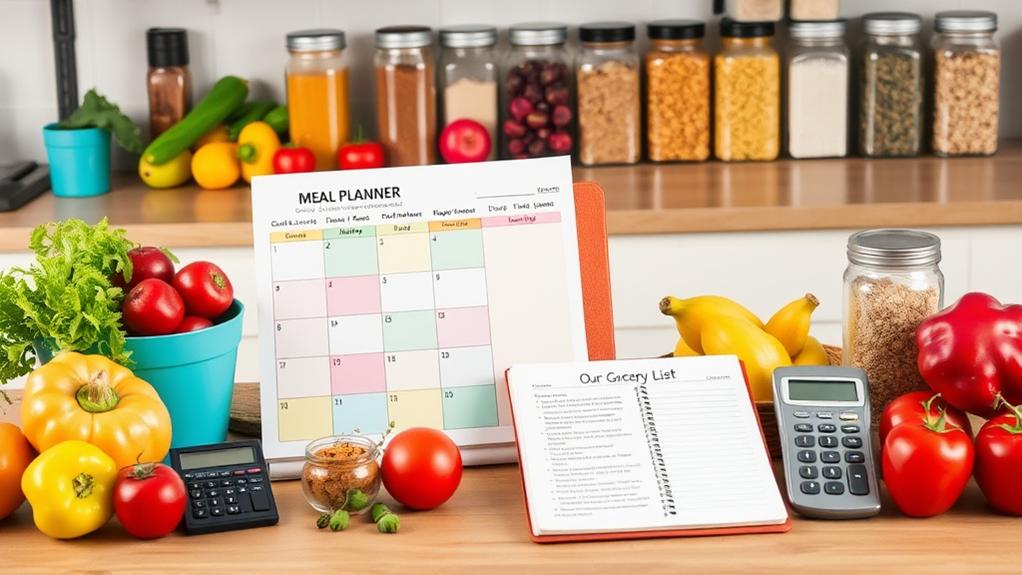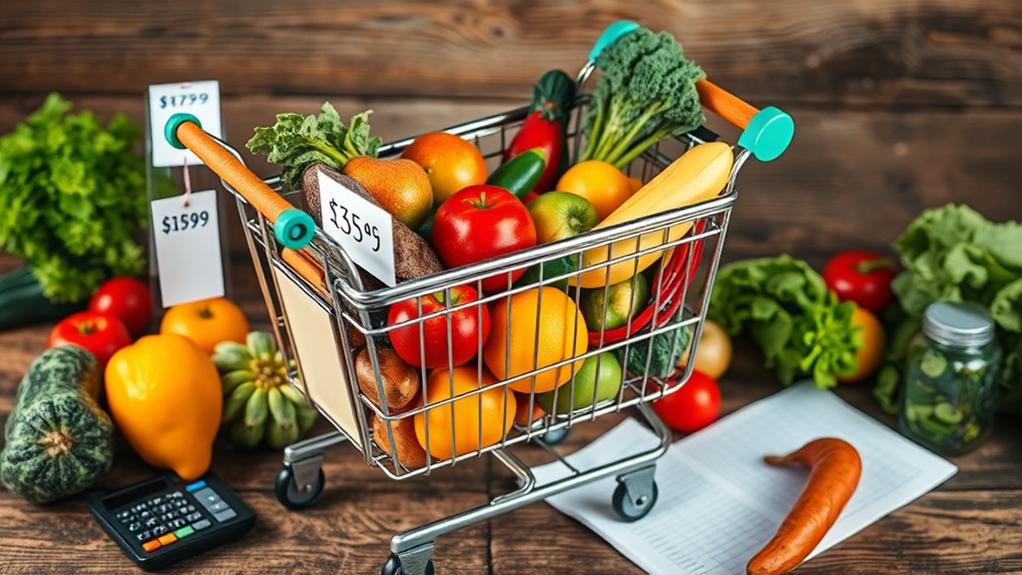10 Money-Saving Tips for Food Shopping
You can greatly cut your grocery bills with these savvy shopping tips. Start by using grocery rewards cards and joining store loyalty programs for discounts. Plan your meals and make shopping lists to avoid impulse buys. Always purchase sale items and opt for seasonal produce to save even more. Avoid pre-packaged products; cooking from scratch is healthier and cheaper. Shop on a full stomach to resist unnecessary snacks. Don't forget to buy in bulk and choose generic brands, which often offer great savings. Keep these strategies in mind, and you'll uncover even more ways to save!
Key Takeaways
- Utilize grocery rewards cards and store loyalty programs to earn cash back and exclusive discounts, potentially saving hundreds annually.
- Plan meals and create shopping lists to avoid impulse buys, reducing monthly grocery costs by $100 to $200.
- Compare prices at various stores and utilize apps to find the best deals, potentially saving over 20% on grocery expenses.
- Purchase seasonal produce for fresher, nutritious options that can lower grocery bills by up to 30% compared to out-of-season items.
- Buy in bulk for significant savings on frequently used items, while opting for generic brands to cut costs by up to 25%.
Use Grocery Rewards Cards

When it comes to cutting down your grocery bills, utilizing grocery rewards cards can be a game-changer. These cards offer you the chance to save money by earning cash back on your purchases. For example, the Blue Cash Preferred Card from American Express gives you an impressive 6% cash back at U.S. supermarkets on up to $6,000 each year, translating into potential annual savings of around $342 based on a typical grocery spend of $5,703. While it does have a $95 annual fee after the first year, the rewards can outweigh this cost.
If you prefer no annual fees, the Blue Cash Everyday Card offers 3% cash back at U.S. supermarkets, plus a $200 welcome bonus after meeting spending requirements. Even generic cash-back cards, like the Citi Double Cash, can earn you 2% on all purchases, making them versatile for your everyday grocery shopping.
Ultimately, it's important to evaluate your shopping habits and consumer spending to select a rewards card that aligns with your financial goals. Embracing these grocery rewards can reveal significant savings, freeing up your budget for other pursuits.
Join Store Loyalty Programs

Joining store loyalty programs can reveal a treasure trove of savings for savvy shoppers. When you join store loyalty programs, you open up automatic discounts at checkout and gain access to exclusive promotions designed just for members. These benefits make food shopping not only more affordable but also more enjoyable.
Many grocery stores tailor personalized deals for loyalty members, allowing you to save considerably on items you buy frequently. Imagine slashing your grocery budget while still stocking up on essentials! Plus, loyalty program members often get early notifications about special sales events, ensuring you don't miss out on fantastic opportunities to save.
Some programs even reward you with points that can be redeemed for cash back or discounts on future purchases, further stretching your dollar. On average, by participating in these programs, you could save around $150 monthly—translating to an impressive $1,800 annually.
Plan Meals and Create Lists

After signing up for store loyalty programs, the next step to maximize your savings is to plan your meals and create grocery lists. By taking the time to plan meals, you can save an estimated $100 to $200 monthly by reducing unnecessary purchases and food waste. Start with a pantry review to see what you already have. This helps prevent duplicate purchases and fosters mindful shopping.
Creating a grocery list based on your planned meals guarantees a focused shopping trip, minimizing impulse buys. When you stick to a list, you can save about 20% on your weekly grocery budget, reinforcing your budget discipline. Consider batch cooking to creatively use leftovers, which further reduces food waste and maximizes your grocery spending efficiency.
Planning your meals not only simplifies your shopping experience but also empowers you to make healthier choices. With thoughtful meal planning and a clear grocery list, you'll navigate the aisles with confidence, knowing you're making smart financial decisions. Embrace this freedom in your shopping habits, and watch your savings grow!
Buy Sale Items

One of the smartest ways to stretch your grocery budget is by buying sale items. Supermarkets often feature discounts on staple items like milk, eggs, and bread, so checking weekly flyers is a must. By planning your meals around these sale items, you can maximize savings and get the most out of your grocery budget.
Consider bulk buying non-perishable goods when they're on sale. This strategy not only saves you money but also cuts down on the frequency of your shopping trips. Seasonal sales, especially around holidays, offer great opportunities to snag discounts on related items, further enhancing your savings.
Don't forget to take advantage of store loyalty programs and digital coupons. Pairing these with sale items can lead to even larger reductions on your grocery bill. For instance, using a digital coupon on a sale item can amplify your discounts considerably.
Incorporating these strategies into your shopping routine will help you make the most of your money and enjoy the freedom that comes with a well-planned grocery budget. So, start hunting those deals and watch your savings grow!
Avoid Pre-Packaged Products

Many shoppers don't realize just how much they can save by avoiding pre-packaged products. By choosing whole items instead, you can greatly cut down your grocery bill. Here are a few ways to make the switch:
- Whole fruits and vegetables: Opting for these can save you up to 50% on produce costs.
- Homemade versions: Cooking from scratch can reduce costs by 20% to 50% compared to pre-packaged meals.
- Bulk ingredients: Buying in bulk not only helps with portion sizes but also allows you to choose fresher, healthier options.
When you avoid pre-packaged products, you're not just saving money on groceries; you're also reducing food waste. Whole ingredients often have a longer shelf life and can be used in multiple recipes. This means less spoilage and more delicious meals at home. Plus, cooking with bulk ingredients ensures you're in control of what's on your plate, leading to healthier meals overall. So, take the plunge and steer clear of those tempting pre-packaged options—you'll enjoy great savings and a greater sense of freedom in the kitchen!
Compare Prices at Stores

Frequently comparing prices at different grocery stores can disclose substantial savings on your shopping trips. You might be surprised to discover that the same items can vary in price by as much as 20% or more between retailers. To simplify this process, consider using apps or websites that track grocery prices, keeping you informed about local sales and promotions.
Regularly checking store circulars and weekly ads is another smart strategy. This practice can reveal discounts and help you plan meals around items on sale, maximizing your savings. Creating a supermarket circuit by visiting multiple stores allows you to identify which locations consistently offer the best prices for specific items—an efficient shopping strategy that pays off.
Additionally, developing an awareness of price trends and seasonal sales can greatly influence your shopping habits. For instance, stock up on non-perishable items during sales to guarantee long-term savings. By making it a habit to compare prices, you empower yourself to make informed choices, ultimately enhancing your shopping experience and keeping more money in your pocket. So, take charge of your grocery shopping and watch your savings grow!
Purchase Seasonal Produce

How much could you save by choosing seasonal produce? By opting for fruits and vegetables that are in season, you can cut your grocery bill considerably—up to 30% compared to out-of-season items! Seasonal produce is not only more affordable, but it's also fresher and more nutritious since it's harvested at its peak. Plus, less transportation means lower costs for you.
Here's how you can make the most of seasonal produce:
- Visit local farmers' markets for the best prices and to support local agriculture.
- Plan your meals around what's in season to enhance flavor and variety.
- Enjoy healthier eating habits by incorporating fresh, nutritious options into your diet.
Shop on a Full Stomach

Shopping on a full stomach can save you a significant amount of money at the grocery store. When you're well-fed, you're less likely to give in to impulse purchases that can derail your budget. Research shows that hunger often leads to cravings for unhealthy snacks and unnecessary items, resulting in spending more than you intended. Many consumers reported saving an average of 20% on their grocery bills by planning their shopping trips right after meals.
Buy in Bulk

Bulk buying is a savvy strategy that can dramatically cut your grocery costs. When you buy in bulk, you often see significant savings on frequently used products like grains, pasta, and canned goods. By shopping at a wholesale club or utilizing bulk bins, you can reduce the unit price and save 20-50% compared to standard retail packages. Here are some items that are perfect for bulk purchasing:
- Non-perishable items like rice and lentils
- Canned goods, which have long shelf lives
- Household staples like pasta and flour
Before you plunge into bulk buying, make certain you have adequate storage space and keep an eye on expiration dates to avoid waste. This way, you maximize your savings while enjoying the freedom that comes with well-stocked pantry essentials. Remember, while some wholesale clubs may charge membership fees, the financial benefits of buying items in bulk can easily outweigh these costs if you shop regularly. Ultimately, by focusing on saving money on groceries, you'll be well on your way to stretching your budget further and enjoying the benefits of bulk purchasing.
Choose Generic Brands

Choosing generic brands can be a game-changer for your grocery budget. When you choose generic brands, you can save money without sacrificing food quality. Many budget-conscious shoppers have discovered that generic products often provide similar taste and quality to their name-brand counterparts, all at a fraction of the price.
Generic items are typically found on the top or bottom shelves, while name brands occupy eye-level spots. This means you might miss out on significant savings if you don't take the time to explore those overlooked options. By purchasing generic products, you could see overall grocery cost reductions of up to 25% or more compared to their more expensive counterparts.
Keep an eye out for store-brand promotions, as these can provide additional savings opportunities. With a wide selection of generic brands available across various categories—from pantry staples to snacks—you can experiment and discover your new favorites. Even when it comes to expensive cuts of meat, you may find that the quality of generic options meets your expectations. Embracing generic brands not only helps you save money but also gives you the freedom to enjoy quality food on a budget.







